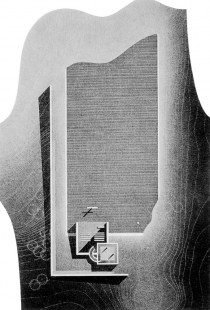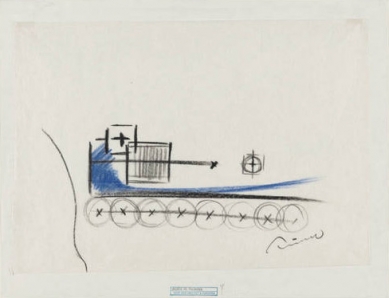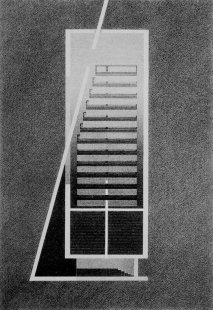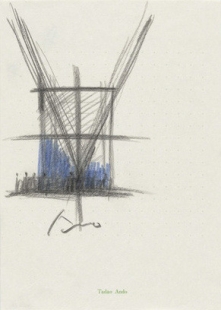
Tadao Ando: From the Water Chapel to the Chapel of Light
Water Chapel is located on a plain in the middle of the Yubari Mountains, northeast of Hokkaido. This area, covered with snow from December to April, is stunning. Water has been artificially brought here from a nearby stream, creating a pond approximately 90 x 45 meters in size. The depth of the pond has been carefully chosen to ensure that the wind effectively acts on the surface and ripples it even with a gentle breeze.
The base of the floor plan consists of two squares, one with a side of 10 meters and the other 15 meters, which partially overlap and are open towards the water. Around them stands a free-standing concrete wall in the shape of an L, encircling them. When you walk outside this long wall, the stream is not visible. You can first see the stream only when you turn 180 degrees at an opening in the wall, then you can see the stream for the first time. Then you ascend a gentle slope and enter a space enclosed by four glass walls. It is essentially a "box" filled with light, where under the blue sky stand four solitary crosses. The frames created by the glass walls and the open sky above allow for a wide view to the horizon. The natural light and space give the visitor a sense of ceremonial solemnity. From here, you then descend a winding, dim staircase towards the chapel itself. The water surface created by the stream opens up before your eyes, and a cross stands on the water's surface. Only one line separates earth and sky - the dichotomy of the worldly and the sacred. The glass wall towards the water surface can be entirely opened, allowing the visitor to be in direct contact with nature. You hear the breeze rustling through the leaves in the branches, the sounds produced by the water, and even birds. These natural sounds seem to underscore the silence. Connected in this way to nature, one can immerse oneself within. The nature within the field of vision is constantly changing.(...)
In designing a series of chapels and churches, I contemplated the sacredness of a place. I asked myself what a sacred place means to me. In the Western conception, a place is sacred because it acts transcendentally - it transcends itself. However, I believe that a sacred place must somehow relate to nature. This, of course, has nothing to do with Japanese animism or pantheism. I am also convinced that my idea of nature is different from what nature actually is. For me, the nature to which the sacred place should relate is the nature created by humans or, better said, the nature that has been impressed with a certain architecture. I believe that when a person abstracts greenery, water, light, or wind from nature in its natural state at will, it approaches sacredness.
Chapel of Light, which is currently under construction, represents an effort to address the means of architecture or abstract, in the aforementioned sense, light as a natural element. The space is almost entirely surrounded by dense concrete walls. Inside, it is truly dark. And in this darkness hovers a light cross. And that is all that is there. The outside light served as a means to the architecture and became an abstract opening in the wall. This lent tension to the space and made it sacred.
The base of the floor plan consists of two squares, one with a side of 10 meters and the other 15 meters, which partially overlap and are open towards the water. Around them stands a free-standing concrete wall in the shape of an L, encircling them. When you walk outside this long wall, the stream is not visible. You can first see the stream only when you turn 180 degrees at an opening in the wall, then you can see the stream for the first time. Then you ascend a gentle slope and enter a space enclosed by four glass walls. It is essentially a "box" filled with light, where under the blue sky stand four solitary crosses. The frames created by the glass walls and the open sky above allow for a wide view to the horizon. The natural light and space give the visitor a sense of ceremonial solemnity. From here, you then descend a winding, dim staircase towards the chapel itself. The water surface created by the stream opens up before your eyes, and a cross stands on the water's surface. Only one line separates earth and sky - the dichotomy of the worldly and the sacred. The glass wall towards the water surface can be entirely opened, allowing the visitor to be in direct contact with nature. You hear the breeze rustling through the leaves in the branches, the sounds produced by the water, and even birds. These natural sounds seem to underscore the silence. Connected in this way to nature, one can immerse oneself within. The nature within the field of vision is constantly changing.(...)
In designing a series of chapels and churches, I contemplated the sacredness of a place. I asked myself what a sacred place means to me. In the Western conception, a place is sacred because it acts transcendentally - it transcends itself. However, I believe that a sacred place must somehow relate to nature. This, of course, has nothing to do with Japanese animism or pantheism. I am also convinced that my idea of nature is different from what nature actually is. For me, the nature to which the sacred place should relate is the nature created by humans or, better said, the nature that has been impressed with a certain architecture. I believe that when a person abstracts greenery, water, light, or wind from nature in its natural state at will, it approaches sacredness.
Chapel of Light, which is currently under construction, represents an effort to address the means of architecture or abstract, in the aforementioned sense, light as a natural element. The space is almost entirely surrounded by dense concrete walls. Inside, it is truly dark. And in this darkness hovers a light cross. And that is all that is there. The outside light served as a means to the architecture and became an abstract opening in the wall. This lent tension to the space and made it sacred.
Tadao Ando: From the Chapel on the water to the Chapel with the light
Source: The Japan Architect 386, June 6/1989, p. 6-17
Translation: Doc. PhDr. Lubomír Kostroň, M.A., CSc. / www.kostron.cz
Source: The Japan Architect 386, June 6/1989, p. 6-17
Translation: Doc. PhDr. Lubomír Kostroň, M.A., CSc. / www.kostron.cz
The English translation is powered by AI tool. Switch to Czech to view the original text source.




0 comments
add comment
Related articles
0
09.03.2013 | Tadao Ando: Agony of Stuck Thoughts - The Trouble with Persistence
0
09.03.2013 | Tadao Ando: The Power of Unfulfilled Vision
0
09.03.2013 | Tadao Ando: Interventions in Circumstances
4
03.03.2013 | Tadao Ando: Materials, Geometry, and Nature
0
03.03.2013 | Tadao Ando: Eternity in a Moment












